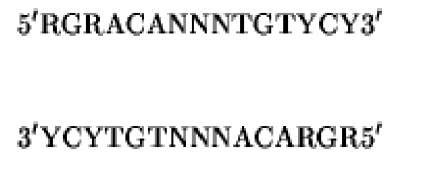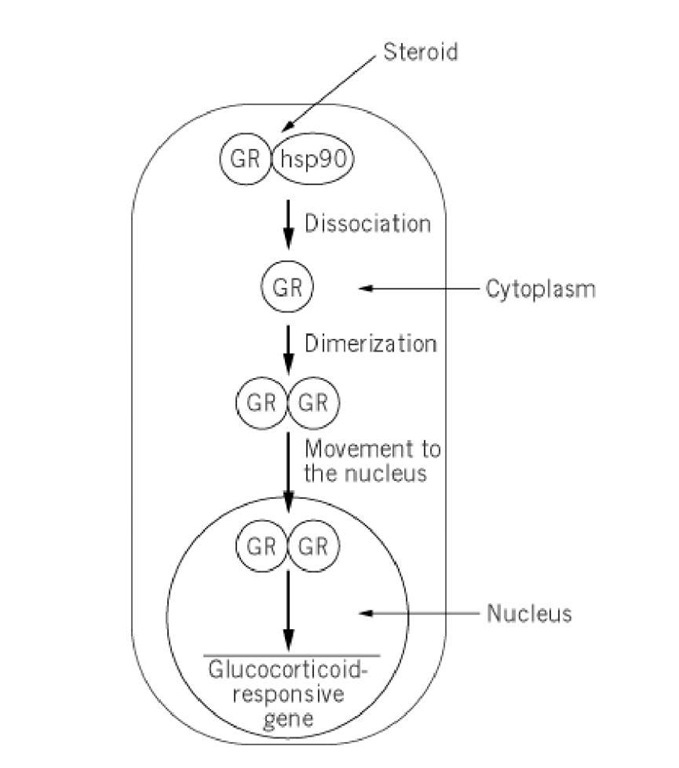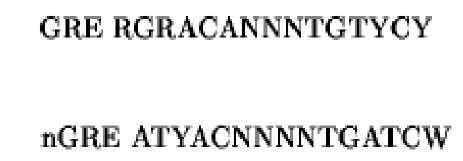The steroid hormones are a group of substances derived from cholesterol that exert a wide a range of effects on biological processes (1) by stimulating the transcription of specific genes (2, 3). These effects on gene expression are mediated by specific response elements within the target genes. The relationships between the different response elements that mediate the response to each of these steroid hormones are discussed in the entry Hormone response elements. This article discusses the sequence that mediates the response to one of the classes of steroid hormones, the glucocorticoids.
The glucocorticoid response element (GRE) is found in a number of different target genes that respond to glucocorticoid. It is a short element with the sequence
where R = purine, (ie, A or G), Y = pyrimidine (ie, C or T), and N = any base. The GRE thus consists of a 6-bp palindrome in which a 6-bp sequence (RGRACA) is repeated in the opposite orientation, with a spacing between the two halves of the palindrome of 3 bp whose sequence does not matter. This palindromic sequence is bound by two molecules of the glucocorticoid receptor in a dimer, which mediates the response to glucocorticoid.
In cells that have not been exposed to steroid, this receptor exists in the cytoplasm complexed to a 90-kDa heat-inducible protein, hsp90. The association with hsp90 anchors the glucocorticoid receptor in the cytoplasm and prevents it activating any genes. Upon exposure to glucocorticoid, the receptor binds to the steroid, which results in the dissociation of hsp90. This leaves the receptor free to dimerize and to move to the nucleus, where the dimer binds to the palindromic GRE (Fig. 1). This binding takes place via specific regions of the receptor known as the DNA-binding domain and the activation domain. The bound receptor then interacts with the basal transcriptional complex of RNA polymerase and associated factors to stimulate transcription of the steroid-responsive gene. In this manner, binding the activated glucocorticoid receptor to the GRE causes the stimulation of glucocorticoid-responsive genes following exposure of the cell to steroid (4).
Figure 1. Activation of the glucocorticoid receptor GR by steroid involves dissociation of hsp90, which permits dimerization of GR and its movement to the nucleus.
Interestingly, the glucocorticoid receptor can also inhibit the expression of specific genes, such a those encoding prolactin and pro-opiomelanocortin. This effect is achieved by the identical recep hormone complex that activates glucocorticoid-inducible genes. However, the DNA sequence element to which the complex binds when mediating its negative effect (nGRE) is distinct from t glucocorticoid response element (GRE) to which it binds when inducing gene expression, but th two sequences are related to one another:
where N = any base, R = purine, Y = pyrimidine, and W = A or T. The similarity between the GRE and the nGRE has led to the idea that the sequence difference causes the receptor-hormone complex to bind to the nGRE in a configuration in which its activation domain cannot interact with the basal transcription complex to activate transcription in the way that occurs following binding to the positive element (5). Indeed, it has been shown that the nGRE in the pro-opiomelanocortin gene binds the glucocorticoid receptor as a trimer, rather than the dimer form that binds to the GRE and stimulates transcription (6). When bound in this manner, the GRE is likely to act simply by preventing binding of a positively acting transcription factor to this or an adjacent site, thereby preventing gene induction. In agreement with this, the nGRE in the glycoprotein hormone a subunit gene overlaps a cyclic AMP response element (CRE) and is able to inhibit gene expression only when the activating CRE is left intact (7).
Hence, the GRE and the related nGRE can bind the glucocorticoid receptor-hormone complex in distinct configurations and thereby allow glucocorticoid hormone to exert either positive or negative effects on the expression of specific target genes.



